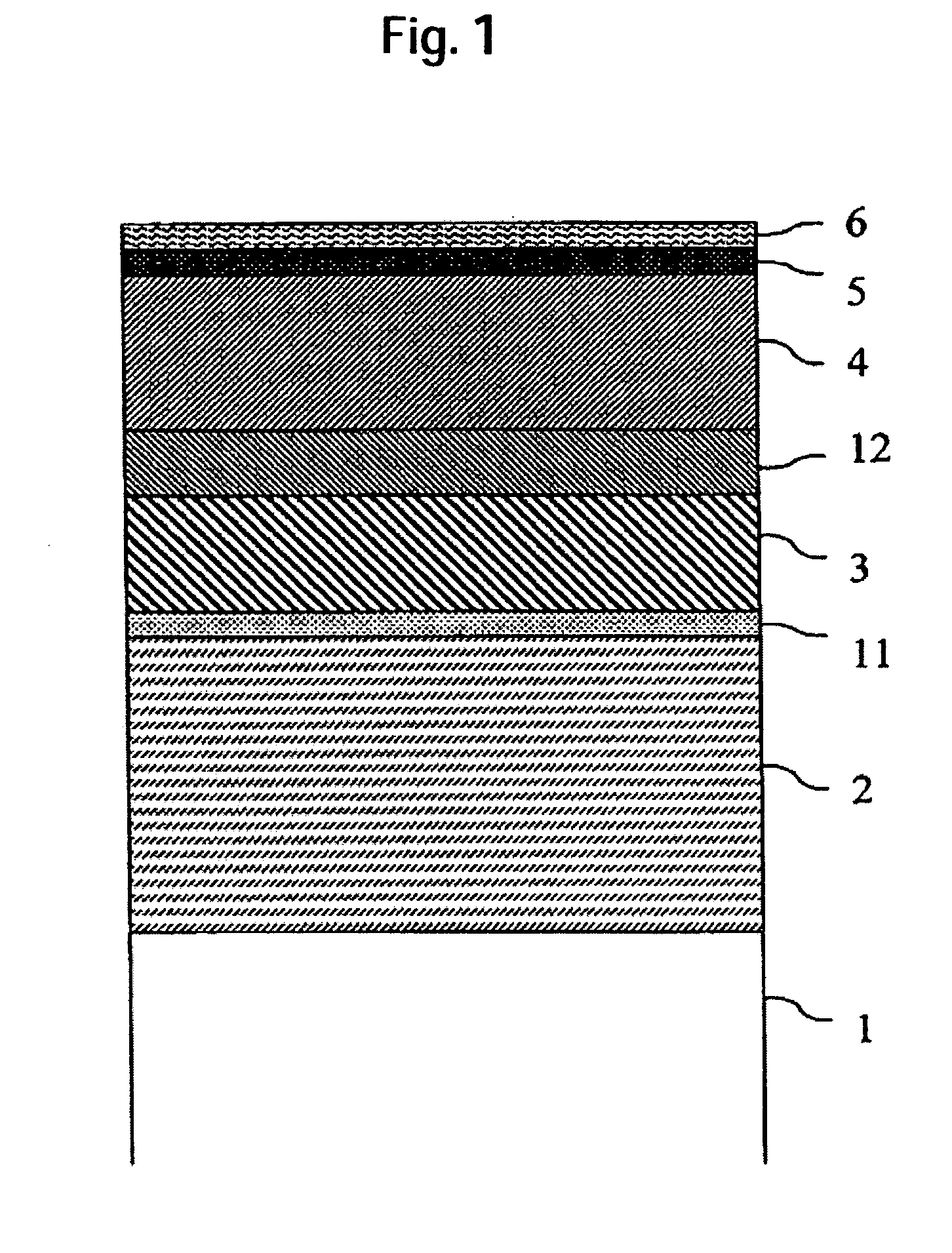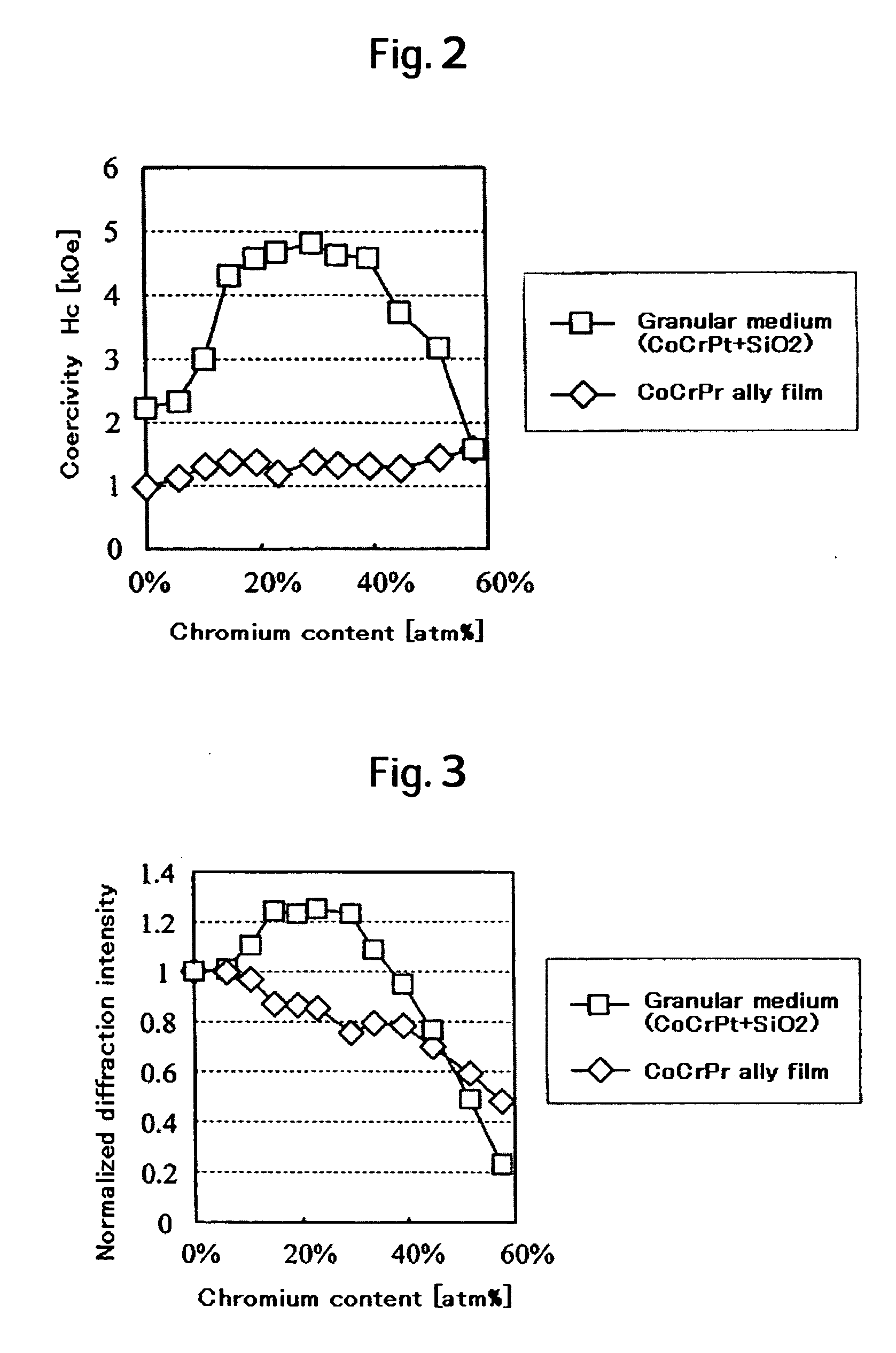Granular recording medium for perpendicular recording and recording apparatus
a perpendicular recording and recording medium technology, applied in the field of magnetic recording, can solve the problems of difficult to obtain and difficult to achieve magnetic characteristics suitable for high density recording compared with the ru undercoating layer, etc., to achieve excellent recording performance and excellent performance
- Summary
- Abstract
- Description
- Claims
- Application Information
AI Technical Summary
Benefits of technology
Problems solved by technology
Method used
Image
Examples
embodiment 1
[0042] A tempered glass substrate for a magnetic recording medium was used as a non-magnetic substrate. After being washed, it was introduced in an in-line type sputtering equipment and a multilayer sputtered thin film was formed by using a DC sputtering technique. In order to ensure the adhesion of the multilayer film to the substrate, at first, a 20 nm thick adhesion layer was deposited by using a Ni65Ta35 target. Then, a 50 nm thick soft-magnetic amorphous film was deposited by using a CoTa3Zr5 target, a 1 nm thick antiferromagnetic coupling film by using a Ru target, and a 50 nm thick soft-magnetic amorphous film by using a CoTa3Zr5 target again, resulting in a triple-layer stacked structure soft-magnetic underlayer being formed. The sputtering Ar gas pressure for each of the above-mentioned layers was controlled to be 1 Pa. Then, a 10 nm thick undercoating layer composed of a PtCr alloy was deposited by discharging a Pt target and a Cr target simultaneously under an Ar gas pres...
embodiment 2
[0049] Embodiment 2 shows the results where the differences of the magnetic characteristics are compared in the case where undercoating layers are fabricated using various materials in lieu of the PtCr alloy undercoating layer described in the embodiment 1 and a material substituted for Pt and Cr is studied. In this embodiment, the recording performance of the medium was evaluated by the SNR value when the linear recording density was assumed to be 420 kFCI, and studies were carried out with the aim of having the SNR value exceed 14 dB when the thickness of the undercoating layer was controlled to be 10 nm.
[0050] A tempered glass substrate for a magnetic recording medium was used as a nonmagnetic substrate. After being washed, it was introduced in an in-line type sputtering equipment, and a multilayer sputtered thin film was formed by using a DC sputtering technique. The deposition conditions of each layer except for the undercoating layer are the same as those of embodiment 1. The...
embodiment 3
[0057] In embodiment 3, perpendicular magnetic recording media fabricated by sandwiching a Ru layer between an alloy undercoating layer of the present invention and a granular recording layer will be described. In this embodiment, the recording performance of the medium was evaluated by the SNR when the linear recording density was assumed to be 420 KFCI and studies were carried out with the aim of having the SNR values exceed 14 dB when the sum of the thicknesses of the first and second undercoating layers was controlled to be 10 nm.
[0058] The structure and the manufacturing method up to the soft-magnetic underlayer was the same as those in embodiments 1 and 2, and then a 6 nm thick first undercoating layer and a 4 nm thick second undercoating layer composed of Ru were fabricated under Ar gas pressures of 2 Pa and 3.5 Pa, respectively. Following this, Ar gas with an oxygen partial pressure of 1.5% was introduced at a pressure of 3.5 Pa and a 15 nm thick granular recording medium w...
PUM
| Property | Measurement | Unit |
|---|---|---|
| thickness | aaaaa | aaaaa |
| thickness | aaaaa | aaaaa |
| thickness | aaaaa | aaaaa |
Abstract
Description
Claims
Application Information
 Login to View More
Login to View More - R&D
- Intellectual Property
- Life Sciences
- Materials
- Tech Scout
- Unparalleled Data Quality
- Higher Quality Content
- 60% Fewer Hallucinations
Browse by: Latest US Patents, China's latest patents, Technical Efficacy Thesaurus, Application Domain, Technology Topic, Popular Technical Reports.
© 2025 PatSnap. All rights reserved.Legal|Privacy policy|Modern Slavery Act Transparency Statement|Sitemap|About US| Contact US: help@patsnap.com



